Related Research Articles
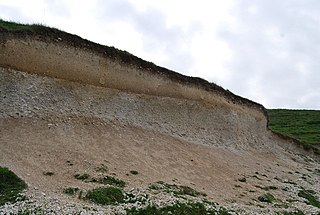
Pedology is a discipline within soil science which focuses on understanding and characterizing soil formation, evolution, and the theoretical frameworks for modeling soil bodies, often in the context of the natural environment. Pedology is often seen as one of two main branches of soil inquiry, the other being edaphology which is traditionally more agronomically oriented and focuses on how soil properties influence plant communities. In studying the fundamental phenomenology of soils, e.g. soil formation, pedologists pay particular attention to observing soil morphology and the geographic distributions of soils, and the placement of soil bodies into larger temporal and spatial contexts. In so doing, pedologists develop systems of soil classification, soil maps, and theories for characterizing temporal and spatial interrelations among soils. There are a few noteworthy sub-disciplines of pedology; namely pedometrics and soil geomorphology. Pedometrics focuses on the development of techniques for quantitative characterization of soils, especially for the purposes of mapping soil properties whereas soil geomorphology studies the interrelationships between geomorphic processes and soil formation.

Sediment is a naturally occurring material that is broken down by processes of weathering and erosion, and is subsequently transported by the action of wind, water, or ice or by the force of gravity acting on the particles. For example, sand and silt can be carried in suspension in river water and on reaching the sea bed deposited by sedimentation; if buried, they may eventually become sandstone and siltstone through lithification.
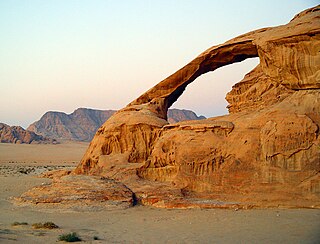
Weathering is the deterioration of rocks, soils and minerals as well as wood and artificial materials through contact with water, atmospheric gases, and biological organisms. Weathering occurs in situ, and so is distinct from erosion, which involves the transport of rocks and minerals by agents such as water, ice, snow, wind, waves and gravity.
Soil formation, also known as pedogenesis, is the process of soil genesis as regulated by the effects of place, environment, and history. Biogeochemical processes act to both create and destroy order (anisotropy) within soils. These alterations lead to the development of layers, termed soil horizon, distinguished by differences in color, structure, texture, and chemistry. These features occur in patterns of soil type distribution, forming in response to differences in soil forming factors.
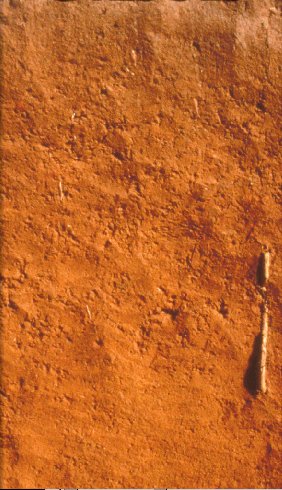
Oxisols are a soil order in USDA soil taxonomy, best known for their occurrence in tropical rain forest within 25 degrees north and south of the Equator. In the World Reference Base for Soil Resources (WRB), they belong mainly to the ferralsols, but some are plinthosols or nitisols. Some oxisols have been previously classified as laterite soils.
The pedosphere is the outermost layer of the Earth that is composed of soil and subject to soil formation processes. It exists at the interface of the lithosphere, atmosphere, hydrosphere and biosphere. The pedosphere is the skin of the Earth and only develops when there is a dynamic interaction between the atmosphere, biosphere, lithosphere and the hydrosphere. The pedosphere is the foundation of terrestrial life on Earth.
A soil horizon is a layer parallel to the soil surface whose physical, chemical and biological characteristics differ from the layers above and beneath. Horizons are defined in many cases by obvious physical features, mainly colour and texture. These may be described both in absolute terms and in terms relative to the surrounding material, i.e. 'coarser' or 'sandier' than the horizons above and below.
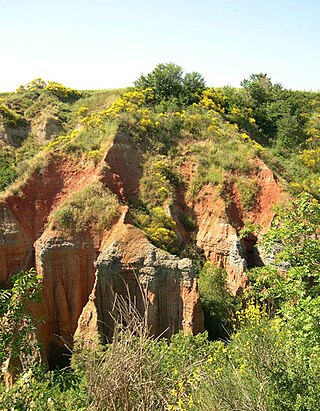
In the geosciences, paleosol is an ancient soil that formed in the past. The precise definition of the term in geology and paleontology is slightly different from its use in soil science.
Orthents are soils defined in USDA soil taxonomy as entisols that lack horizon development due to either steep slopes or parent materials that contain no permanent weatherable minerals.

Entisols are soils defined in USDA soil taxonomy that do not show any profile development other than an A horizon. An entisol has no diagnostic horizons, and most are basically unaltered from their parent material, which can be unconsolidated sediment or rock. Entisols are the most abundant soil order, occupying about 16% of the global ice-free land area.
The paleopedological record is, essentially, the fossil record of soils. The paleopedological record consists chiefly of paleosols buried by flood sediments, or preserved at geological unconformities, especially plateau escarpments or sides of river valleys. Other fossil soils occur in areas where volcanic activity has covered the ancient soils.

Paleopedology is the discipline that studies soils of past geological eras, from quite recent (Quaternary) to the earliest periods of the Earth's history. Paleopedology can be seen either as a branch of soil science (pedology) or of paleontology, since the methods it uses are in many ways a well-defined combination of the two disciplines.
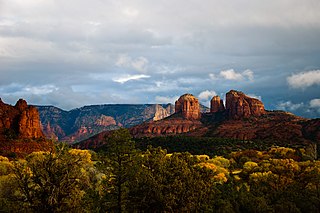
Red beds are sedimentary rocks, typically consisting of sandstone, siltstone, and shale, that are predominantly red in color due to the presence of ferric oxides. Frequently, these red-colored sedimentary strata locally contain thin beds of conglomerate, marl, limestone, or some combination of these sedimentary rocks. The ferric oxides, which are responsible for the red color of red beds, typically occur as a coating on the grains of sediments comprising red beds. Classic examples of red beds are the Permian and Triassic strata of the western United States and the Devonian Old Red Sandstone facies of Europe.
Soil morphology is the study of the formation and description of soil types within various soil horizons. C.F. Marbut championed reliance on soil morphology instead of on theories of pedogenesis for soil classification because theories of soil genesis are both ephemeral and dynamic.
Soil chemistry is the study of the chemical characteristics of soil. Soil chemistry is affected by mineral composition, organic matter and environmental factors. In the early 1870s a consulting chemist to the Royal Agricultural Society in England, named J. Thomas Way, performed many experiments on how soils exchange ions, and is considered the father of soil chemistry. Other scientists who contributed to this branch of ecology include Edmund Ruffin, and Linus Pauling.
There have been known various classifications of landslides. Broad definitions include forms of mass movement that narrower definitions exclude. For example, the McGraw-Hill Encyclopedia of Science and Technology distinguishes the following types of landslides:

Terra rossa is a well-drained, reddish, clayey to silty soil with neutral pH conditions and is typical of the Mediterranean region. The reddish color of terra rossa is the result of the preferential formation of hematite over goethite. This soil type typically occurs as a discontinuous layer that ranges from a few centimeters to several meters in thickness that covers limestone and dolomite bedrock in karst regions. The high internal drainage and neutral pH conditions of terra rossa are a result of the karstic nature of the underlying limestone and dolomite. Terra rossa is also found associated with Mediterranean climates and karst elsewhere in the world.

Laterite is both a soil and a rock type rich in iron and aluminium and is commonly considered to have formed in hot and wet tropical areas. Nearly all laterites are of rusty-red coloration, because of high iron oxide content. They develop by intensive and prolonged weathering of the underlying parent rock, usually when there are conditions of high temperatures and heavy rainfall with alternate wet and dry periods. Tropical weathering (laterization) is a prolonged process of chemical weathering which produces a wide variety in the thickness, grade, chemistry and ore mineralogy of the resulting soils. The majority of the land area containing laterites is between the tropics of Cancer and Capricorn.
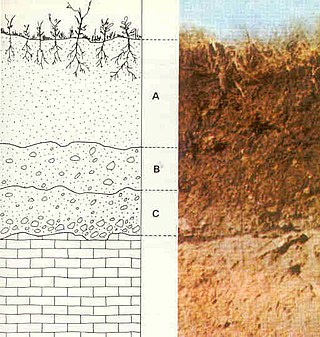
Saprolite is a chemically weathered rock. Saprolites form in the lower zones of soil profiles and represent deep weathering of the bedrock surface. In most outcrops its color comes from ferric compounds. Deeply weathered profiles are widespread on the continental landmasses between latitudes 35°N and 35°S.

The Chinese Loess Plateau, or simply the Loess Plateau, is a plateau in north-central China formed of loess, a clastic silt-like sediment formed by the accumulation of wind-blown dust. It is located southeast of the Gobi Desert and is surrounded by the Yellow River. It includes parts of the Chinese provinces of Gansu, Shaanxi and Shanxi. The depositional setting of the Chinese Loess Plateau was shaped by the tectonic movement in the Neogene period, after which strong southeast winds caused by the East Asian Monsoon transported sediment to the plateau during the Quaternary period. The three main morphological types in the Loess Plateau are loess platforms, ridges and hills, formed by the deposition and erosion of loess. Most of the loess comes from the Gobi Desert and other nearby deserts. The sediments were transported to the Loess Plateau during interglacial periods by southeasterly prevailing winds and winter monsoon winds. After the deposition of sediments on the plateau, they were gradually compacted to form loess under the arid climate.
References
- ↑ "Glossary". L'Association Française pour l'Etude des Sols (AFES). Archived from the original on 2006-03-07. Retrieved 2006-06-01.
- ↑ Gérard Hugonie. "Morphogenetic system". Archived from the original on March 13, 2007. Retrieved April 28, 2012.
- ↑ Douglas, I; K. Bidin; G. Balamurugan; N. A. Chappell; R. P. D. Walsh; T. Greer (1999). "The role of extreme events in the impacts of selective tropical forestry on erosion during harvesting and recovery phases at Danum Valley, Sabah". Philosophical Transactions of the Royal Society of London. Series B: Biological Sciences. 354 (1391): 1749–1761. doi:10.1098/rstb.1999.0518. PMC 1692689 . PMID 11605619.
- ↑ Phillipe Audra (2004). "An Overview of the Research Being Carried Out in the French Western Alps Karst" (PDF). Acta Carsologica. 33 (1): 25–44. Archived from the original (PDF) on July 18, 2011. Retrieved April 28, 2012.